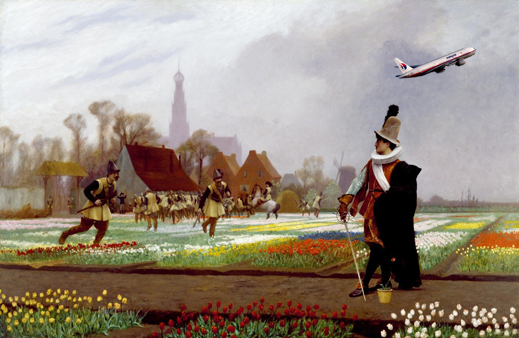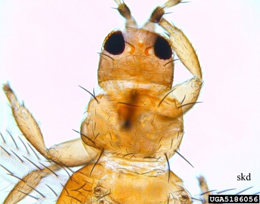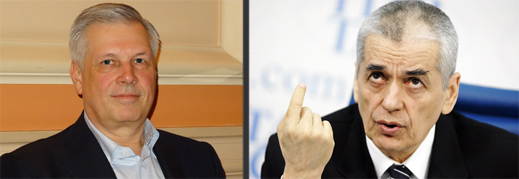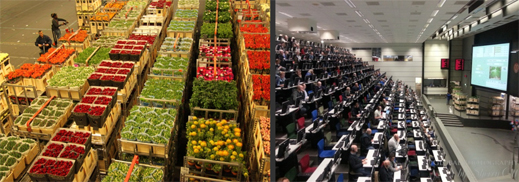Yves here. This post is fun. It also gives a case study of how a monopolist connives to preserve its advantaged position.
By John Helmer, the longest continuously serving foreign correspondent in Russia, and the only western journalist to direct his own bureau independent of single national or commercial ties. Helmer has also been a professor of political science, and an advisor to government heads in Greece, the United States, and Asia. He is the first and only member of a US presidential administration (Jimmy Carter) to establish himself in Russia. Originally published at Dances with Bears

The Dutch auction, as it’s called in the wholesale flower trade of Europe, is a clever scheme which simulates competitive bidding while it hides premiums in the prices Dutch growers and traders rig for their flowers. To cut the cost of flowers you have to deadhead the Dutch. And that’s exactly what Russia is threatening to do this week.
The Dutch are crying foul. That’s what monopolists usually do when the game is up. In Dutch history going back to the time when the Amsterdam merchants held a monopoly on the world supply of nutmeg – a prophylactic against bubonic plague , it was believed at the time — they organized slavery, torture, and other atrocities to protect their nutmeg trading scheme. Before you jump to condemn the Russian phytosanitary authority for issuing a warning against Dutch flower exports, remember the Amboyna Massacre of March 9, 1623.*
Rosselkhnoznadzor (RSN), the state veterinary and phytosanitary agency in Moscow, has issued a request for the European Union (EU) to suspend its phytosanitary certification for the shipment of flowers from the Netherlands. Press reports describing this as an import ban are premature, RSN said yesterday. “The ban has not formally been introduced,” according to spokesman Yulia Melano. On the other hand, for practical purposes she concedes the ban has commenced. “We have only asked for consultation with our European colleagues. We have asked [them] to voluntarily and temporarily stop certification of this product for deliveries to the territory of Russia.” RSN has warned that if the EU will not do that, then RSN will formally introduce its own ban. RSN spokesman Alexei Alexeyenko said last week the talks with the EU phytosanitary officials had yet to start.
 The Monday, July 27, announcement from RSN claims the reason for the import control request is that infestation has been discovered in more than half of test lots of cut flower imports from the Netherlands over the past three months. One of the culprits identified by RSN inspectors is the western flower thrip (right). Another is the even more notorious leafminer, Liriomyza trifolii, whom every gardener knows.
The Monday, July 27, announcement from RSN claims the reason for the import control request is that infestation has been discovered in more than half of test lots of cut flower imports from the Netherlands over the past three months. One of the culprits identified by RSN inspectors is the western flower thrip (right). Another is the even more notorious leafminer, Liriomyza trifolii, whom every gardener knows.
Along with Rospotrebnadzor (RPN), the consumer protection agency, the RSN’s chief Sergei Dankvert (below, left) has often been accused in the foreign press of pursuing a trade protection or political agenda, on behalf of the Kremlin. The former RPN chief , Gennady Onishchenko (right), was replaced in 2013 after allegations of excessive zeal, insufficient evidence. Their targets have included cucumbers from Spain, German cheese, Egyptian potatoes, American pork, Moldovan wine, and Australian kangaroo and lamb. For the backfile, documenting that the Russians are not alone in running such alleged trade protectionist schemes, see.

Unlike the foodstuffs, cut flowers have mostly been an import to Russia, though local farm enterprises and the Kaluga region joint venture with the Dutch, Rose Garden, are growing in volume and sales at better than 20% per annum. Until now, domestic market sales are estimated to be worth at least $1 billion yearly. According to this Russian market survey for 2012-2013, more than two-thirds of sales come from imports; up to 80% of imports come from Holland. Roses originate primarily from Ecuador; chrysanthemums and carnations from Colombia; orchids from Thailand.
After sharp growth in Dutch exports to Russia of cut flowers in 2012 and 2013 – as the table shows, Russia ranked 4th largest on the Dutch cut-flower trading table – there has been a sharp contraction.
TOP-10 DESTINATIONS FOR EXPORTS OF CUT FLOWERS FROM THE NETHERLANDS
(in millions of Euros)

Source: http://www.hbagbloemen.nl
By the end of March 2014 – that’s before the war against Russia had got under way at NATO headquarters – the Dutch export value for Russia, including bulbs and pot plants, was down 5% on the quarter; down 23% on the month. The sharpness of the decline was even greater if bulbs and potted plants are left out, and only cut flowers counted. The worm in the bud had started early in the year; the rot accelerated after the Dutch government followed Washington and London in blaming Moscow for the downing of Malaysian Airlines MH17 on July 17. Of the 298 crew and passengers killed, 192 were Dutch.
In 2012 FloraHolland (Koninklijke Coöperatieve Bloemenveiling, Royal Cooperative Flower Auction), the Dutch floriculture marketing organization, reported its total turnover of cut flowers, bulbs and pot plants at €4.28 billion, growing at just 3%. But growth in Russian sales was more than 40% that year. Last year, the Dutch exports to Russia had dropped substantially, and FloraHolland conceded there was “reason for concern.”
FloraHolland reports in its annual financial statements that on turnover of more than €4 billion – comprising more than 6 million lots, almost 13 million units – the market expenses run to about 9%; after-tax profit is 0.2%. For the accounts, click.
By October of 2014, analysts of the Dutch flower trade claimed the reasons for the trade reversal were the Ukraine conflict; the introduction of sanctions against Russia; and the devaluation of the rouble. This has been amplified by US Government outlets like Radio Liberty and Bloomberg. According to the radio this week, the proposed import ban “would aggravate tensions between the two countries already at odds over the downing of flight MH17”. The Dutch Federation of Agriculture and Horticulture (LTO) was more cautious, saying nothing about the export ban. But Bloomberg got the LTO spokesman, Maarten Leseman, to claim the phytosanitary violations announced by RSN in Moscow are “just an excuse for the Russian government to ban flowers. The real reason is political. The tribunal could be the real reason.”
He is referring to Dutch demands for a United Nations tribunal to prosecute those responsible for the MH17 crash. For the Dutch rush to judgement, read the backfile here. On July 16 President Vladimir Putin (left) warned Dutch Prime Minister Mark Rutte (right), in a telephone call the latter initiated, that the Dutch and Americans were “leaking various overtly politicized versions of the events to the media”.

A closer look at the Russian cut flower trade reveals just as much disinformation. Here is an American business school study of how the Dutch work to rig the international flower market. “In a number of ways, the Dutch auction (pictured below) favors growers over buyers. First, the clocks move at high speeds, reducing buyer decision-making time and causing higher bid prices. Experiments have shown that higher speeds result in higher prices. Second, the service costs to buyers favors small lots over large lots. Thus no one party can purchase the entire lot without competition.”

The Aalsmeer flower market, world’s largest trading centre for cut flowers, near Schiphol airport, Amsterdam.
The scheme is already generating resistance among buyers, encouraging direct trade between the lowest-cost flower-producing countries and the high-value flower-consuming countries. According to the US study, “some large retailers like Marks and Spencer [UK] are bypassing the Dutch auctions and their commissions to source directly from growers in Spain and other countries.”
The Dutch acknowledge the result is a visible shift in import flows, and the elimination of the Dutch trade intermediaries. Here’s Rabo, the Dutch bank, admitting in January of this year, that African, Asian and South American countries are taking market share away from Holland:

Source: RaboBank: https://www.rabobank.com
FloraHolland admits “the Dutch share in global flower and plant production is decreasing. Growers increasingly sell their products without the direct intervention of FloraHolland and they operate further up the chain more often than before. The importance of the auction clock decreases as the use of electronic sales resources rises. It has to be said, however, that in 2014 this took place slower than expected.”

Source: RaboBank: https://www.rabobank.com
The map suggests there’s no obvious geographic reason why flower shipments shouldn’t go direct to Russian ports on the Black or Baltic Sea, and why the Russian flower trade shouldn’t move upstream, investing in flower cultivation, just as the Russian banana trade did in Ecuador several years ago. For the banana story, read this. Smuggling, other corruption and bankruptcy have put a sorry end to that tale.
For the start of Russia’s affair with Ecuadorian roses, start reading in 1998, when Russian flower entrepreneurs began using Miami as their transhipment point, avoiding Amsterdam. The high cost of air freighting flowers paid off on special occasions, like Women’s Day March 8. But on an all-year round basis, the profit margin for the importers was a modest 12%. This was also the result of the large number of importers and wholesalers in the Russian market, and the intensity of competition between them. In 1998, Business Bouquet, headed by Valery Stayen, estimated that the regular companies on the market numbered 20, importing 300,000 roses per week. For special flower days on the Russian calendar, the number of importers tripled.
Today, 17 years later, Stayen and Business Bouquet are still in business. But Stayen refuses to name the top-5 or top-10 companies in the trade. He won’t answer questions either about the scope for direct trade, avoiding the Dutch market, or the impact of the proposed ban.
Talia Akhmetova, head of the press service at Florist.ru, a leading Russian internet retailer, estimates that “about 90% of all flowers sold in the country are imported. About 60% of them are imports from the EU. They not only provide almost the entire volume of the Russian market, but also the range. Holland, Italy and France, the largest producers of flowers and plants, in Europe, have a huge territory with a first-class equipment, and in addition, a suitable climate for growing flowers. All this affects the quality of the flower, which has remained unchanged throughout the year. Among the flowers imported from the EU countries there are re-exports from Colombia, Kenya, Ecuador, Israel, Turkey and other countries, but the proportion is very small, about 10% to 20%. There are also direct deliveries from South America, but this amount is not systemically significant, except for roses.”
Asked whether the Russian market can reorient its imported supplies from the other countries, she said “it is more expensive to carry flowers directly from South America, Kenya, Ecuador, etc. into Russia because the volumes will be smaller than those flowing into and out of the Dutch auctions. The cost of logistics for transportation to Russia of relatively small volumes undoubtedly affects the purchase price.”
Asked to identify the top-5 Russian importers of cut flowers, and their market shares, Akhmetova said: “unfortunately, because of the opacity of the flower market, such data cannot be identified. Accurate estimation of the volume of imports is impossible because of illegal, gray market deliveries. That is, the flowers which have not passed through certification and control at [the Dutch] flower auctions, are transported across the Russian border without documents.”
Philip de Jong, the Dutch trade representative at his embassy in Moscow, is also mute. Asked to identify the principal Russian importers and traders of Dutch cut flowers, he refused, and referred instead to the Russian Agriculture Ministry, which has yet to respond.
Reports on the domestic industry between 2012 and 2014 by Olga Ivanova identify the top-5 importers of cut flowers as Uraltorgservice, Impulse, Exim, Baltic Gift, and Impulse-Fruit. They reportedly account for no more than 31% of the import volume. The five leading wholesalers, according to earlier data for 2012, were Obi Logistics, CFC, Moneymaker, Agricultural Services, and Uraltorgservice. They account for no more than 40% of volume. In Moscow, Obi and CFC are in the top-5; also Flower Jet, Starlight, and Imdeko. They have a combined market share of 50%. According to Ivanova, Moscow city accounts for up to 23% of Russia’s flower sales, followed by St. Petersburg and Moscow region, with 13% and 18%, respectively.
Part of the reluctance of industry sources to identify the market leaders is that their market shares are relatively small; their names keep changing; and the gray trade is sizeable. Comparing the Dutch export numbers for Russia with the corresponding Russian import numbers for the Netherlands reveals that about $30 million worth of flowers have been crossing the Russian border which haven’t been registered at origin as Russia-bound exports. That’s about 10% of the Russian import total. Industry sources estimate the value of the gray market in imported flowers as larger than that. Dutch export sources say they have no idea of the value of the gray trade, and can’t account for the $30 million discrepancy in the trade figures.
Speaking from Holland for the Dutch flower traders today, Leseman expressed the hope that the ban will not be introduced. “So far there is no official decision by the Russian side, or by the EU, to suspend certification and ban Dutch flower exports.”
NOTE: the lead image is of The Tulip Folly, a painting of 1882 by the French artist, Jean-Léon Gérôme. He was depicting the scene in 1632 when speculation on the price of tulips created a bubble the Dutch market authorities tried to let down by ordering soldiers into the tulip fields to destroy the supply. A nobleman has drawn his sword to protect his investment in an unusual potted tulip. A decade earlier, the Dutch in the islands now known as Indonesia bribed local plantation owners, attacked British merchants, and put the Balinese into slavery to keep the supply of nutmeg to themselves. At Amboyna the Dutch governor trumped up treason charges against 17 Englishmen; waterboarded them into false confessions; and chopped their heads off. The murders became a cause for the first Anglo-Dutch war, which the British won in 1654. The Dutch were then obliged to pay compensation to the families of the victims. That came to £3,615. The nutmeg story can be read in full here.
Comments enabled at the request of the author


Bugs live on flowers! Who knew. Now 2% of dutch flower exports are threatened! Wow! Russians are funny.
Who knew. Now 2% of dutch flower exports are threatened! Wow! Russians are funny.
i guess you’re a pro at irony cuz you point out the typical “look at russians they’re country bumpkins” attitude endemic among the powers that be. pretty much sums up the US diplomacy with Russia which is—why bother conducting diplomacy with bumpkins.
“Bugs live on flowers! Who knew. Now 2% of dutch flower exports are threatened! Wow! Russians are funny.”
So the Dutch are going to have to check 100% of their flowers heading to Russia to legally certify that thay are free of pests. That should start eating into growers profits quite quickly. If they don’t certify, then all 100% can be blocked.
If the Dutch want to pay fast and loose, then can’t complain when they suffer blowback.